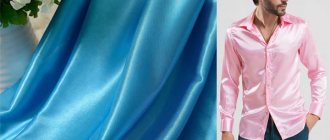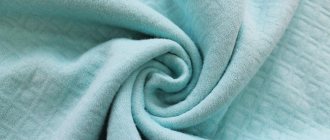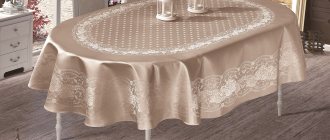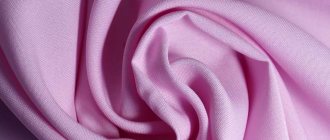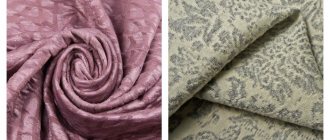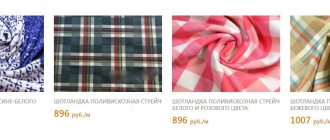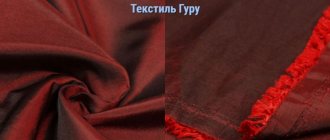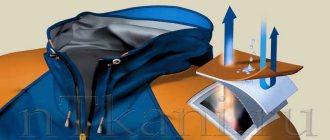Artificial silk is a beautiful, thin and comfortable material that looks very similar to its natural counterpart. At the same time, with a much more attractive cost, improved physical characteristics and a less labor-intensive production process.
It is not surprising that artificial silk material is very popular and in demand. The fabric is made from natural cellulose, subject to chemical treatment. Meanwhile, it should not be confused with synthetic, which is made from petroleum products - from polyesters.
What kind of fabric is this?
So, we found out that silk can be natural, artificial and synthetic.
- The first is high-quality material, which is made from protein compounds in the cocoons of silkworm caterpillars. Several thousand years ago, the technology was mastered in Ancient China and for many centuries it was kept a strictly secret. Only members of the imperial family could afford to wear clothes made of natural silk. With the development of the Great Silk Road, the fabric came to the West, but due to the labor intensity, high cost and length of the manufacturing process, it was available only to the highest strata of society. So people began to try to invent an analogue of natural matter, similar in appearance and properties, but different in price and ease of production.
- Artificial silk is a soft and elastic material, with a slight sheen and a smooth surface. Externally, it is very similar to natural one, but the fiber from which artificial silk is made has nothing to do with the secretion of the silkworm caterpillar. The name “artificial” is more of a household name. It is more correct to call the fabric viscose or acetate. These are two categories of wood cellulose fabrics produced from different types of fiber, cellulose hydrate and cellulose ether, respectively. The fabrics are pleasant to the touch, hypoallergenic, soft, wear-resistant, and easy to dye.
- The raw materials for the production of synthetic silk are petroleum products. This fabric practically does not wrinkle, but also does not allow air or moisture to pass through. It is the cheapest analogue of natural silk fabric.
Production stages
So, we have found out what kind of fabric this is, artificial silk, and then we will talk about the process of its production. Let us repeat, natural wood cellulose is used for this purpose. Surely you are wondering what trees artificial silk is made from, we will be happy to explain. Most often, beech, spruce, fir, pine or even cotton fluff is used for this purpose.
Above we explained how artificial silk is correctly called - viscose or acetate.
Viscose is obtained from crushed wood raw materials. First it is boiled, then washed and dried. Next, they are immersed in hot alkali, in which the product swells. In the next step, it is dried and crushed again. To bring the raw material to a homogeneous composition, it is treated with oxygen, carbon disulfide and dissolved in sodium. After a few days, pure viscose is formed from cellulose. The product is filtered and passed through the press of a spinning machine, from which it comes out in the form of very fine streams. The latter are immersed in acid, where they harden and turn into threads. Next, they are pulled out, twisted, washed, dyed and woven into linen.
They learned to produce acetate material much later than viscose material, significantly simplifying the production process. The same wood cellulose is used as a raw material. The raw materials are soaked at a temperature of 140°, as a result, acetic esters are released from the cellulose. The latter are dissolved in acetone with the addition of water or alcohol. After filtering and drying, the solution is pressed through a press. Next, the alcohol and acetone evaporate, leaving only the thinnest streams at the exit, which, upon cooling, turn into threads. The latter are used to spin the finished fabric.
The manufacturing process of acetate fabric is somewhat simpler than viscose, and the properties of the resulting fabrics do not differ much. Perhaps acetate is less resistant to alkali, so it needs to be washed with delicate products. It dries faster because it practically does not absorb moisture. Also, this matter is slightly electrified and is afraid of high heat. All other properties of both types of cellulose silk are the same.
Production
There are two main stages of production - obtaining viscose and spinning the fiber.
- First, cellulose is isolated from wood (by boiling in a special solution), then water is added to it, laid out on a conveyor and dried.
- Then an alkali solution is added to it (when heated), it swells.
- After this, the alkali cellulose is squeezed out and crushed, oxidized with oxygen, treated with carbon disulfide and dissolved in sodium hydroxide.
- The resulting solution matures for several days, and viscose is obtained.
- Next, the viscose is filtered and passed through the spinnerets of a spinning machine, thin streams fall into a precipitation bath with acid, solidify, and the fiber is obtained in the form of threads, which can subsequently be cut into staple viscose fiber.
Fabric properties
Well, we have examined in detail what artificial silk is made of, and then we will consider the characteristics of this fabric.
- It is soft and smooth to the touch;
- Permits air and moisture well;
- Has hypoallergenic properties;
- Draps well, lends itself well to tailoring;
- Keeps color for a long time, does not fade;
- Resistant and strong with proper care;
- When dry it is very strong;
- When wet, it loses elasticity and strength, so you need to wash it carefully;
- Easily wrinkles;
And here you can read how to wash a shirt collar quickly.
The composition of artificial silk fabric also determines its bactericidal properties - after all, in fact, natural raw materials are used. Yes, it is subjected to chemical action, but this technology only improves the physical properties of the raw material - cellulose.
The considered properties of artificial silk allow us to describe what it looks like. This is a magnificent airy material with a glossy shine, smooth and flowing. It is soft, elastic to the touch, retaining its bright color perfectly and persistently. At first glance, artificial silk is difficult to distinguish from natural silk, which is why the product is so popular. In the middle of the 20th century, its production in terms of turnover was 8 times higher than the production of the original material from the silkworm cocoon.
Application
Acetate was widely used during Soviet times. Beautiful inexpensive dresses were made from it. Today it has been replaced by synthetics, also inexpensive, but more durable.
Today the following are made from acetate:
- scarves;
- scarves;
- home textiles;
- sleep kits;
- robes.
Advice. Artificial silk bedding looks very impressive, but it slips and slides, and therefore creates a lot of inconvenience during use. A sheet with an elastic band solves the problem to some extent.
As for viscose, it remains relevant.
They sew from it:
- bed sheets;
- home textiles (bedspreads, pillowcases, curtains, tablecloths, curtains);
- carpets, knitting yarn;
- skirts, dresses, trousers, jackets;
- ties, dressing gowns, pajamas, shirts for men.
How to distinguish artificial from natural?
If you remember what artificial silk is, and according to experts, in appearance it is almost no different from natural silk, you will still want to know how not to confuse them. After all, the price difference between materials is gigantic.
So, how to distinguish real silk from artificial, as well as from synthetic?
- Synthetics do not wrinkle at all. It does not allow air and moisture to pass through.
- The artificial composition is similar in properties to the natural one, but wrinkles more strongly and loses strength when wet;
- This fabric has more pronounced characteristics, and also warms in summer and cools in winter. It wrinkles and is afraid of heating.
Even if you know exactly how artificial silk differs from natural silk, down to the smallest details of the production process, there will always be a risk that you will not be able to distinguish the fabric by appearance. Here we will tell you how to wash silk items, be sure to read.
To find out for sure which sample you got into your hands, try setting fire to the thread:
- Natural silk smolders without supporting the flame. If you remove the match, the burning will stop. At the same time, the smell of burning hair or feathers is felt. The remaining material crumbles to dust;
- Artificial burns like paper - with a characteristic smell, smoke and flames. Raw materials quickly turn to ash;
- Synthetics melt, stink of plastic, and in the end you are left with a solid melted mass in your hands.
Scope of application
Well, we found out what artificial silk is, what its properties are, a description of its appearance, and we provided a photo of the material. In conclusion, let's talk about where it is used, in what industry.
It is logical to indicate textile first. What can you sew from artificial silk, what do you think?
- Clothes - home, casual and festive;
- Underwear;
- Accessories – scarves, stoles, bags;
- Home textiles – curtains, tablecloths, bed linen;
- Yarn for knitting;
Viscose silk fibers are also used as a filling for premium quality pillows.
Artificial silk materials will serve you faithfully and for a long time, but only with proper care. They should be washed on a delicate cycle or by hand. Try to use gentle detergents, preferably in liquid form. Spinning and twisting, as well as drying while thrown over a rope are prohibited. You need to iron on the “Silk” mode at low temperature, strictly from the wrong side. Next, find out what kind of fabric modacrylic is, we will tell you everything in detail at the link.
Other meanings of this word:
- "country" for sun protection
- "Hat" between two Americas
- "hat" between the Americas
- "hat" on the American isthmus
- "Hat" country
- (city) the capital of the state of Panama with a population of 1,063,000 people, located at the entrance of the Panama Canal to the Pacific Ocean. Panama City
- Goal. dress
- Headwear for a vacationer
- Headdress; state in America; textile; major fraud
- State in America
- State in Latin America
- State in Central America and its capital
- a state in Central America that is “worn” on the head
- state and hat
- The state that is “carried” on the head
- Both the hat and the country
- Which country has the domain "pa"?
- Which country owns the top-level domain. pa
- Which capital is “worn” on the head?
- Major fraud
- Major fraud involving bribery of senior officials
- Major fraud, scam (the meaning appeared after the collapse of the first joint-stock company for the construction of the famous canal)
- Light summer hat
- Light beach hat
- Light summer hat with small brim
- Summer headdress
- Summer light hat
- Summer fabric hat
- Summer fabric hat with soft brim
- summer fabric hat with soft brim, summer hat
- summer wide-brimmed straw or fabric hat
- Summer wide-brimmed hat, wicker or fabric
- Summer hat
- Fraud on a grand scale
- On the coat of arms of which state is there an image of a shovel and a hoe as a reminder of the country's past?
- In fact, this is a hat from Ecuador, and it got its name from the country that became the center of their trade. What country is it
- the name of this country in the language of local Indians means “village of fishermen”
- Beach hat with brim
- Close to Costa Rica and Colombia
- capital (since 1903) and port of the state of Panama at the Pacific entrance to the Panama Canal
- Capital of Panama
- Country and hat
- country between two Americas
- A country between two Americas
- Country on your head
- Country with Balboa currency
- country with a crazy name
- A country with a “hat” name.
- country divided by canal
- single color artificial silk fabric
- Rayon fabric, usually one color
- a fabric made from various fibers of a characteristic weave in which two or more weft threads intersect with two or more warp threads.
- Beach hat
- Sun hat
- wide brim summer hat
- Hat - wear it to the beach
- Hat - go to Anapa
- Hat in the summer heat
- beach hat
- sun hat
- Beach Hat
- hat - wear it to the beach
- hat - go to Anapa
- A hat directing thoughts towards the resort
